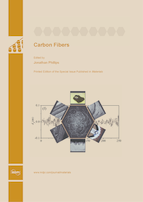Carbon Fibers
A special issue of Materials (ISSN 1996-1944).
Deadline for manuscript submissions: closed (28 February 2014) | Viewed by 89105
Special Issue Editor
Interests: heterogeneous catalysts; carbon materials; plasma generated materials; dielectrics metal particle synthesis; material-radical interactions; energy storage; microcalorimetry; mossbauer spectroscopy; quantum mechanics; plasma physics
Special Issues, Collections and Topics in MDPI journals
Special Issue Information
Dear Colleagues,
Remarkably, truly novel structures are still being found for materials made of a single element: carbon. Perhaps there is a ‘revolution’ in carbon-only materials. Indeed, recently, two Nobel prizes were awarded for new forms of carbon: for fullerenes in 1996, and for graphene in 2010. Yet, there is still more to discover and to explain. In this Special Issue, we invite original papers relating to just one area of carbon research: fibers. Papers on carbon fibers classified as phenomenological, application-focused, fundamental, or some combination of the aforementioned are all invited. Phenomenological topics of interest include the impact of operating parameters (e.g., gas phase, catalyst, temperature, etc.) on growth rate, fiber size, strength, conductivity, thermal properties, and corrosion resistance. Papers that include information regarding any application of carbon are welcome (e.g., applications in next-generation integrated circuits, capacitors, high strength materials, composite materials, sensors, etc.). Fundamental issues of interest to the editor and others include the mechanism of growth, the role of catalysts, surface chemistry and the means to modify it, and ad/bsorption processes. I look forward to submissions from many old friends and to making new friends.
Prof. Dr. Jonathan Phillips
Guest Editor
Manuscript Submission Information
Manuscripts should be submitted online at www.mdpi.com by registering and logging in to this website. Once you are registered, click here to go to the submission form. Manuscripts can be submitted until the deadline. All submissions that pass pre-check are peer-reviewed. Accepted papers will be published continuously in the journal (as soon as accepted) and will be listed together on the special issue website. Research articles, review articles as well as short communications are invited. For planned papers, a title and short abstract (about 100 words) can be sent to the Editorial Office for announcement on this website.
Submitted manuscripts should not have been published previously, nor be under consideration for publication elsewhere (except conference proceedings papers). All manuscripts are thoroughly refereed through a single-blind peer-review process. A guide for authors and other relevant information for submission of manuscripts is available on the Instructions for Authors page. Materials is an international peer-reviewed open access semimonthly journal published by MDPI.
Please visit the Instructions for Authors page before submitting a manuscript. The Article Processing Charge (APC) for publication in this open access journal is 2600 CHF (Swiss Francs). Submitted papers should be well formatted and use good English. Authors may use MDPI's English editing service prior to publication or during author revisions.
Keywords
- carbon fiber
- properties
- applications
- growth mechanism
- catalysis
- surface chemistry







